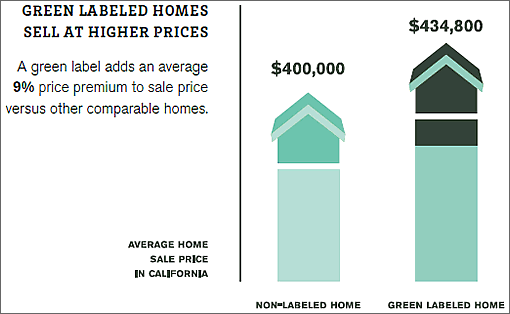
From San Francisco’s Assessor-Recorder’s office with respect to their new Green Labels for properties in San Francisco: “While no re-assessments will be triggered by earning an environmental distinction for your home, there is evidence that a Green Label enhances the re-sale value.”
The aforementioned evidence was in the form of an academic study, The Value of Green Labels in the California Housing Market, financed by the San Francisco Department of the Environment and StopWaste.Org. The key finding from the report:
This study, conducted by economists at the University of California, Berkeley and University of California, Los Angeles, finds that California homes labeled by Energy Star, LEED for Homes and GreenPoint Rated sell for 9 percent more (±4%) than comparable, non-labeled homes.
Because real estate prices depend on a variety of factors, the study controlled for key variables that influence home prices including location, size, vintage, and the presence of major amenities such as swimming pools, views and air conditioning.
Considering that the average sales price of a non-labeled home in California is $400,000, the price premium for a certified green home translates into some $34,800 more than the value of a comparable home nearby.
∙ Green Labels Migrate From Marketing Materials To Property Records [SocketSite]
∙ The Value of Green Labels in the California Housing Market [builditgreen.org]
Green label is simply marketing.
There’s no such thing as a 5000 sq ft green building. The amount of energy it takes to run a home that size is huge, no matter how many solar panels it has on the roof. Something that big still needs tons of water to clean the floors and operate the air filtration systems.
There’s nothing environmentally sound about demolishing a house then installing huge amounts of imported solar panels, newly manufactured bamboo flooring that comes largely from unregulated industries in China, and the other materials that come from great distances. LEED certification ignores the waste created by any projects as the measurement begins with the opening of the building, not with the demolition and disposal. This makes a little economic sense with large office buildings and towers that last for dozens of years, but not with homes which are relatively small & often remodeled by every owner.
Also, the number of LEED certified buildings that have consumed backyards, genuine green of trees and bushes, is staggering. By destroying the large swaths of dirt and vegetation, especially nesting trees, migration patterns are undermined or destroyed, fewer trees means less CO2 processing, so less oxygen, and by forcing people to take trips to the outdoors rather than use their backyards, there’s more pollution created.
So much that’s called “green” is simply choosing how little of the ecosystem to label.